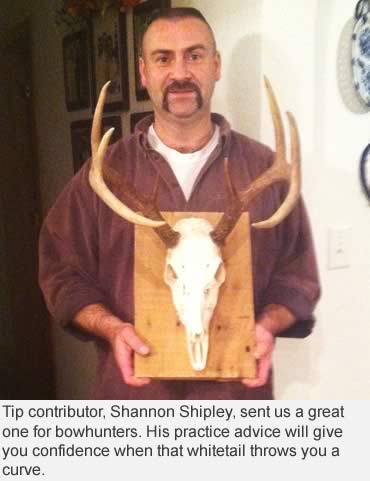By Shannon Shipley and Tim H. Martin
When getting ready for bow season, I have learned to practice shooting for all sorts of scenarios.
No two situations are alike when it comes to the moment of truth for shooting whitetails. I like to prepare for the unexpected, and my practice routine includes shooting at every angle imaginable.
The only way to properly do this is to replicate a hunting situation as closely as possible. This means actually practicing from a treestand, along with wearing the same clothes you will be wearing when hunting.
Putting on all my gear, including thermal underwear and safety harness, allows me to eliminate the unexpected on the practice range, as well as learn which shots I can and cannot take.
When a big buck walks out, you don’t want to discover the tightness of your harness hinders your draw. And that’s not the time to learn your bowstring slaps your jacket sleeve.
Practicing from the elevation of the treestand also allows me to fine tune my bow’s accuracy. Some bows will shoot slightly differently at ground level. Make sure you bring Allen wrenches to make necessary pin adjustments while in the tree.
It also helps to bring along a friend to shag arrows and tie them to a hoist rope, so you won’t have to exhaust yourself climbing up and down the tree.
 Lots can go wrong in ground blinds, too, so I also replicate hunting scenarios from them. Before opening day, I range objects, practice shooting targets at various yardages and make sure I know my limitations for shooting out of the windows.
Lots can go wrong in ground blinds, too, so I also replicate hunting scenarios from them. Before opening day, I range objects, practice shooting targets at various yardages and make sure I know my limitations for shooting out of the windows.
One more thing: Consider lengthening your draw length a tad to compensate for bulky clothing. On a cold morning, put on ALL your hunting clothes, draw your bow and determine if you need to let out your sting to compensate.
The animal deserves a perfectly placed shot, so replicate ALL hunting situations during practice to make that one arrow count.
– Editor’s Note by Tim H. Martin
Shannon’s tip reminds me of the time I missed a 9-point buck at five yards — FIVE.
I’d spent the entire off-season practicing to get tight groups from 20 to 60 yards on the bow range. In my zeal to be an accurate long-range archer, I’d never considered what my bow might do if a deer came directly beneath my stand.
But that’s exactly what happened on a crisp October afternoon.
The old boy appeared suddenly at 40 yards and stopped behind a tree at 15 yards. I drew my bow and waited for it to step out, which it did, but didn’t offer a shot until it stood so close that I could see its eyelashes.
I simply put the pin of my trusty old pendulum sight on the buck’s chest and released, smooth as silk.
To my amazement, the arrow flew two inches below the buck! It trotted 32 yards away, and stopped to see what caused the noise. This was a fatal mistake, and I sent arrow No. 2 into its boiler room.
Only later, while practicing from a treestand, did I replicate the shot and discover my pendulum sight stops rotating on shots inside of 10 yards. This caused the miss.
Had I practiced a 5-yard shot from my treestand, I would have known to aim higher to compensate for the sight’s limitations. Luckily, the buck gave me one of the scarcest things in bowhunting — a second chance.
— Support Photo Courtesy Shannon Shipley
Read Recent Tip of the Week:
• Backstraps and tenderloins: Are they the same thing? Have you gotten it wrong for years? The answers might surprise you! (Includes recipes)